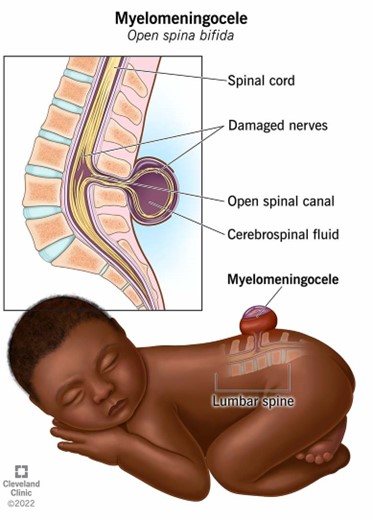A nurse is orienting a newly licensed nurse in the care of an infant who has myelomeningocele.
Which of the following actions by the new nurse indicates the teaching has been effective?
Takes an axillary temperature.
Places the infant in a side-lying position.
Maintains a dry dressing over the sac.
Performs range of motion on the infant's hips.
The Correct Answer is A
A. Infants with spina bifida, including those with myelomeningocele, have an increased risk of rectal anomalies, so avoiding rectal temperatures is essential. The correct and safe method of temperature measurement for these infants is typically axillary.
B. Placing the infant in a side-lying position is not recommended for a child with myelomeningocele. The preferred position is prone to avoid pressure on the sac and reduce the risk of rupture and infection.
C. Maintains a dry dressing over the sac: While the sac should be kept covered, it is typically kept moist with sterile saline-soaked gauze to prevent it from drying out and to minimize the risk of infection.
D. Performs range of motion on the infant's hips: Range of motion exercises might be indicated later on, but initially, the focus is on protecting the sac and preventing complications.

Nursing Test Bank
Naxlex Comprehensive Predictor Exams
Related Questions
Correct Answer is ["A","B","C","D","E"]
Explanation
The nurse should include all of these points in the teaching.
A. Avoiding bubble baths can help prevent irritation and infection.
B. Watching for manifestations of infection can help detect any worsening or recurrence of the infection.
C. Emptying the bladder completely with each void can help prevent urine from remaining in the bladder and causing infection.
D. Wiping the perineal area front to back can help prevent bacteria from
spreading to the urethra.
E. Wearing cotton underpants can help keep the area dry and reduce the risk of infection.

Correct Answer is D
Explanation
Having a psychiatric disorder, such as depression, anxiety disorder, or bipolar disorder, is a significant risk factor for suicide in adolescents.
Choice A is not correct because while family conflict can be a contributing factor to suicide risk, it is not the greatest risk factor.
Choice B is not correct because homosexuality itself is not a risk factor for suicide; however, discrimination and bullying related to one’s sexual orientation can increase suicide risk.
Choice C is not correct because while the availability of firearms can increase the likelihood of a completed suicide attempt, it is not the greatest risk factor for suicide.
Whether you are a student looking to ace your exams or a practicing nurse seeking to enhance your expertise , our nursing education contents will empower you with the confidence and competence to make a difference in the lives of patients and become a respected leader in the healthcare field.
Visit Naxlex, invest in your future and unlock endless possibilities with our unparalleled nursing education contents today
Report Wrong Answer on the Current Question
Do you disagree with the answer? If yes, what is your expected answer? Explain.
Kindly be descriptive with the issue you are facing.
